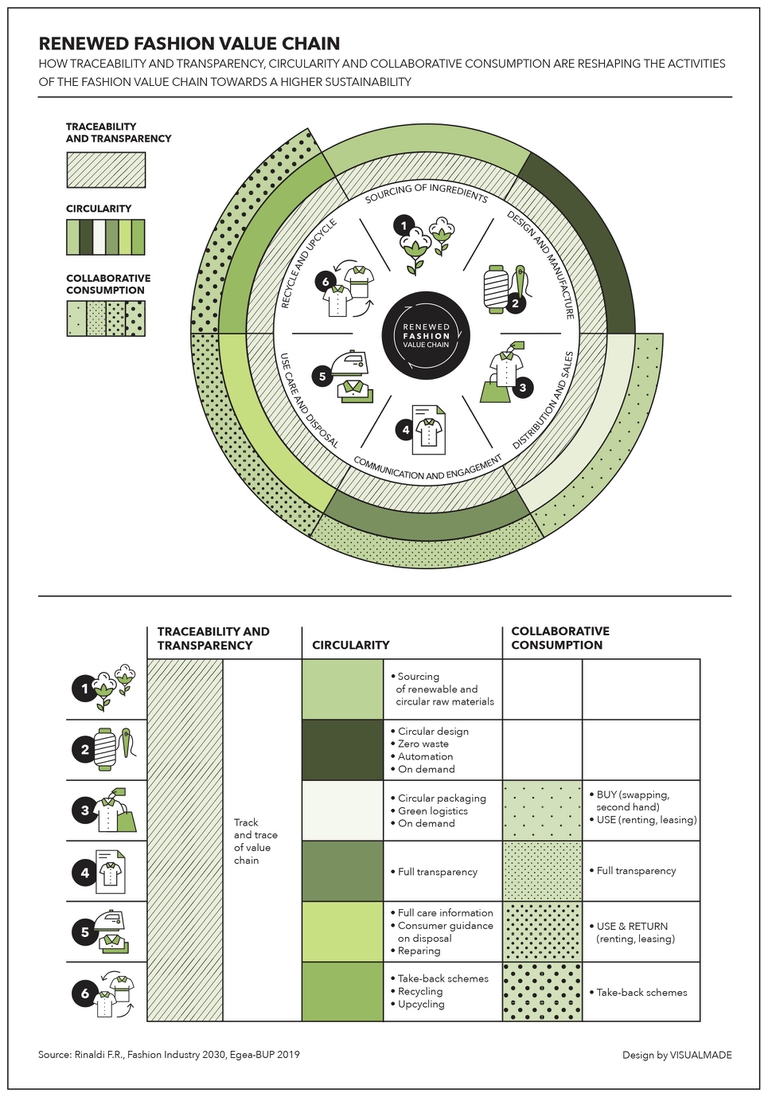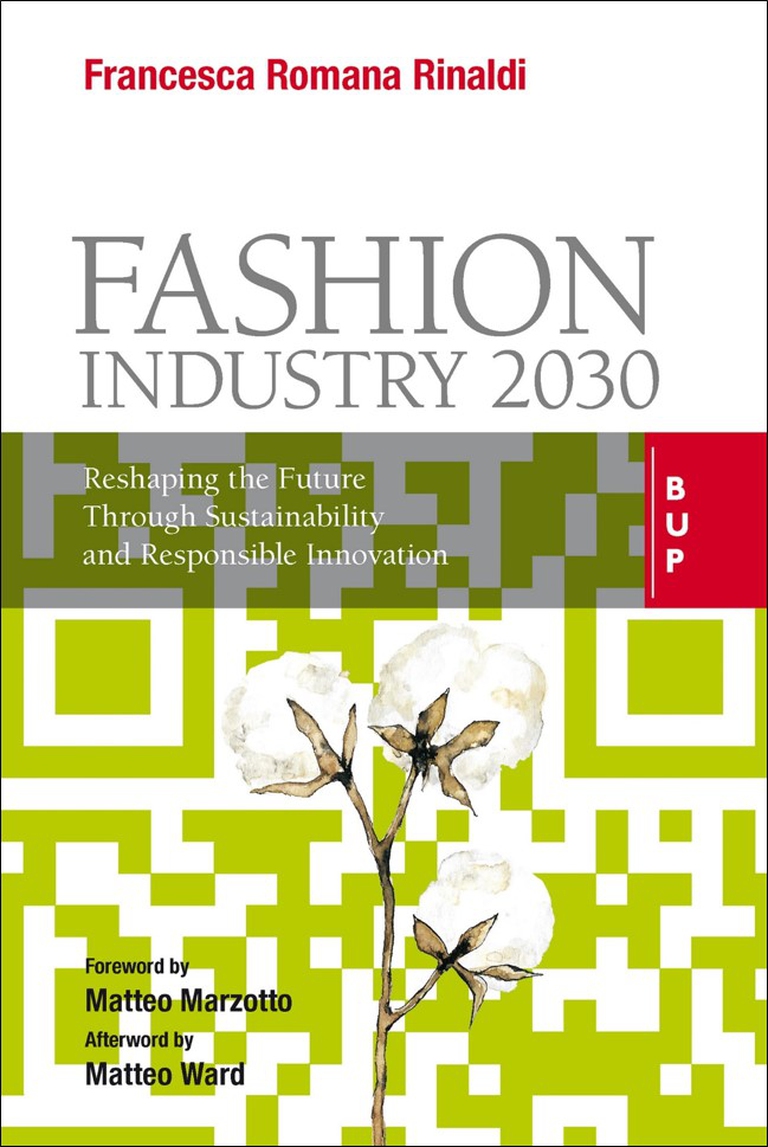
By recovering clothes discarded in the West, Togolese designer Amah Ayiv gives them new life through his high fashion creations.
The book Fashion Industry 2030 aims to contribute to reshaping the future through sustainability and responsible innovation. An exclusive opportunity to read its introduction.
We need a fresh perspective to understand how the fashion industry will change in the coming years, in a decade we know will be crucial for our future. Once the health emergency has been overcome, we’ll be faced with an even bigger challenge: the climate and environmental crisis. Most of Earth’s “illnesses” depend on this emergency. And the current situation confirms, once again, that we can’t possibly live healthily on an ailing planet. Francesca Romana Rinaldi – author of Fashion Industry 2030, published by Egea, and sustainable fashion ambassador – takes us on a journey to explore the most complex sector facing this transition. What emerges is the importance of issues such as transparency and traceability, circularity as well as collaborative consumption. Following is the introduction to the book Fashion Industry 2030.
Let’s imagine the fashion industry in 2030. It won’t be the same as today simply because of the sustainability pressures it faces. Key data highlight the need for an immediate change. At the G7 Summit that took place in 2019 at Biarrits (France), 32 major brands signed the “Fashion Pact”, a document aimed at aligning the fashion industry with the UN Sustainable Development Goals (SDGs) to focus action on three gaps related to “climate”, “biodiversity” and “oceans” with objectives drawn on the Science-Based Targets (SBT) Initiative. For instance, 20 per cent of the industry is now committing to net-zero carbon emissions by 2050 and the use of 100 per cent renewable energy across own operations with the ambition to incentivize implementation of renewables in all high impact manufacturing processes along the entire supply chain by 2030 and eliminating the use of single use plastics (in both B2B and B2C packaging) by 2030. Is this enough?
The book Fashion Industry 2030 – Reshaping the Future through Sustainability and Responsible Innovation supports the thesis that an urgent and radical change is needed, both on the demand side and the supply side. Consumers interested in sustainability will influence other segments by asking for more information, as they already do. Brands will be accustomed to explaining who made their products – and how and where they were made. Those same brands will have to develop new business models based on a value proposition that integrates ethics, aesthetics and innovation as fashion sustainability becomes a widely publicized issue. This thesis has been partially discussed in the book The Responsible Fashion Company. Long-term economic balance in a company can only be achieved by incorporating economic short-term objectives, which are essential for the remuneration of capital and labour. Other non-economic objectives include the relationship with the environment, society, culture, the media, institutions, legislation and, most of all, the perspective of values and ethics.
Today, applying a multi-stakeholder approach for the integration of ethics and aesthetics may not be enough: there is a new need to reshape business models through responsible innovation.
This book investigates changes in the fashion industry towards sustainability and responsible innovation. The different chapters will focus on the key drivers that are propelling the industry towards the 4th Industrial Revolution. They answer the following questions:
Key contributions by opinion leaders (company CEOs and entrepreneurs, institutions, associations, journalists, activists, etc.) are included. Among the many interviews conducted, some have been incredibly inspiring – for instance that with Nino Cerruti, in the Biella industrial district, cradle of high-quality textiles, located not so far away from the Italian fashion capital. Mr. Cerruti, who represents the third generation of one of the few companies still able to control the complete cycle of wool, from the Australian sheep to the Parisian catwalks, stated during an exclusive interview for this book:
I think that the word sustainable is highly inflated and polluted and does not give the consumer the expected guarantee of meaning. For this reason, we need to start by giving this connotation a new definition that should be in relation to the actual level of quality and to the value that is connected to the aesthetical content. Only in this way can we give due respect back to fashion and textiles.

This is exactly the starting point: the word “sustainability” must take on new meaning. This empirical, case-oriented and interview-based approach will help explain how responsible innovation must be seen not only as a driver to update business models, but also as the only way to ensure medium- and long-term economic sustainability.
Chapter 1 starts with a topical debate on fashion companies and their important social role; the idea that the integration of ethics and aesthetics may not be enough is also discussed. Then, the concept of responsible innovation is introduced.
In Chapter 2, the characteristics of consumers interested in sustainability are analysed, exploring the many definitions of this consumer segment, the various clusters in existence and the specific communication tools to narrate sustainability in fashion, according to the different consumers’ expectations.
In Chapter 3, Porter’s Value Chain linear model is reinterpreted towards a “Renewed Fashion Value Chain” model to introduce the business models that will be available in the fashion industry by 2030: this is the core chapter that links the whole book together.
Chapter 4’s focus is on transparency and traceability for sustainable value chains in the fashion industry: their role as crucial enablers of more responsible production and consumption patterns is examined.
Chapter 5 is dedicated to technologies for traceability and supply chain protection, with a key focus on anti-counterfeiting.
Chapter 6 looks at how to manage circularity in fashion. The findings of the most updated reports on circular textiles and clothing are presented, together with a discussion of best practices underlying the opportunities and challenges of circularity in fashion.
Chapter 7 describes the opportunities of Collaborative Fashion Consumption (CFC). It presents the main business models and positive environmental effects and challenges of CFC (i.e. rental, subscription-rental and recommerce), following discussion of best practices.
Chapter 8 focuses on the description of the B-Corp certification and of the Benefit Corporation legal form. The case studies provide the reader with concrete examples of how some key players in the fashion industry have developed effective and innovative ways of incorporating sustainability principles into their everyday business practices.
Chapter 9 discusses the future of fashion towards 2030 and presents the point of view of several opinion leaders. Emerging technologies, such as wearables, blockchain, IoT, Augmented Reality (AR), Virtual Reality (VR), 3D printing, robotics, Artificial Intelligence (AI) and machine learning are discussed. These elements are driving the industry towards the 4th Industrial Revolution. Some open questions will be then presented at the end of our journey across the different drivers of change: Which are the technologies that will disrupt more the industry and will drive business models towards a higher sustainability in fashion? Is blockchain a buzzword or it will really be the “internet of the future”? How is automation going to transform economies and the workforce?
To sum up, by 2030 the chances are high that some new rules of the game will reshape the business models of successful companies in the fashion industry:
By 2030, fashion companies will try to achieve 100 per cent transparency and traceability. They will involve the consumers in their circular value chains, giving them many options to prolong the life of the product. Fashion companies will put consumers’ needs much more at the centre through product customization, on-demand collections, the omnichannel approach, transmedia storytelling and one-to-one communication. Thanks to AI it will be possible to craft effective user experiences, where all stakeholders will be active in the fashion value chains so the industry will be much more inclusive. Fashion companies will go from producing and distributing products to offering more personalized services such as repairing, renting and recommerce. In a nutshell, fashion companies of the future will be integrating aesthetics, ethics and responsible innovation.
Siamo anche su WhatsApp. Segui il canale ufficiale LifeGate per restare aggiornata, aggiornato sulle ultime notizie e sulle nostre attività.
![]()
Quest'opera è distribuita con Licenza Creative Commons Attribuzione - Non commerciale - Non opere derivate 4.0 Internazionale.
By recovering clothes discarded in the West, Togolese designer Amah Ayiv gives them new life through his high fashion creations.
All catwalks in July will be broadcast online: after Paris, it’s Milan Digital Fashion Week’s turn. And the biggest beneficiary is the environment.
From fashion to design, from architecture to construction, biomaterials and their applications are constantly multiplying. And designers are responding to this revolution in many different ways.
A new study on linen, presented at the Milano Unica trade show, highlights the material’s numerous advantages and low environmental impact.
Victor Papanek spearheaded social and sustainable design based on political awareness rather than consumerism. A biography of the author of Design for the Real World.
Two world-famous designers, Ross Lovegrove and Marcel Wanders, on the relationship between plastic and design. The stimulus for this conversation was offered by an exhibition at the past Milan Design Week inviting 29 designers to rethink their approach to this (now) demonised material.
Getting people to consume less is important, but it’s not enough. There has to be a cultural shift, and design is likely to have a key role in transforming our approach to plastics.
A journey to discover leather tanneries in Dhaka, the capital of Bangladesh, among terrible working conditions, pollution and laws left unenforced.
Yona Friedman is a visionary and innovative architect and theorist. We met him during the inauguration of the installation he made in occasion of the Milan Design Week.








